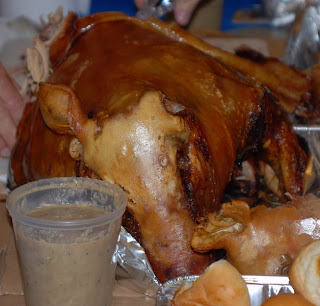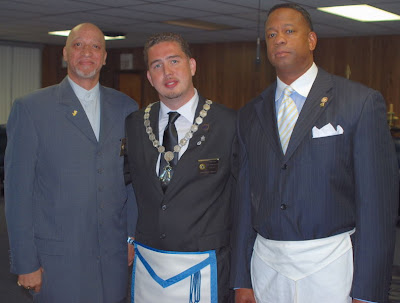
Visitors to the Newman Catholic Community Center at Drexel University in Philadelphia are greeted by audacious symbolism. The fresco rendering of the iconic color photograph of earthrise taken from the lunar surface lends context to the most incomprehensible phrase in human vocabulary: ‘In the beginning, God...’ Superimposed upon it all is the Chi-Rho mounted on a cross. The Chi-Rho, one of the oldest symbols denoting Christianity, is a combination of the Greek letters chi (X) and rho (P), the first two letters in the Greek spelling of Christ, meaning ‘king.’
On the 40th anniversary of mankind’s arrival on the moon, thoughts inevitably turn to the significance of the moon in Masonic symbolism. There is much to consider.
“The adoption of the moon in the Masonic system as a symbol is analogous to, but could hardly be derived from, the employment of the same symbol in the ancient religions,” says the 1924 edition of Mackey’s An Encyclopædia of Freemasonry and its Kindred Sciences. “In Egypt, Osiris was the sun, and Isis the moon; in Syria, Adonis was the sun, and Ashtoroth the moon; the Greeks adored her as Diana, and Hecate; in the mysteries of Ceres, while the hierophant or chief priest represented the Creator, and the torch-bearer the sun, the officer nearest the altar represented the moon. In short, moon-worship was as widely disseminated as sun-worship. Masons retain her image in their Rites, because the Lodge is a representation of the universe, where, as the sun rules over the day, the moon presides over the night; as the one regulates the year, so does the other the months, and as the former is the king of the starry hosts of heaven, so is the latter their queen; but both deriving their heat, and light, and power from Him, who as the third and the greatest light, the Master of heaven and earth, controls them both.”
Freemasonry as we know it is a product of the Enlightenment, meaning, in part, it is a philosophical society intended for the improvement of man’s station. Its use of universal symbols leads to great confusion among those who mistake it for anything from a continuation of the ancient mystery religions to a form of neo-paganism, like Wicca. Those who hold these opinions miss the point that above all else it is reason that Masonry aims to inculcate, not nature worship. It is thoughtful inquiry into the essence of nature we are taught to pursue, and not satisfaction with the superficial mindset that accepts Creation on par with the Creator.
“Whoever reflects on the objects that surround him will find abundant reason to admire the works of Nature, and adore the Being who directs such astonishing operations,” writes Bro. Charles Leslie in A Vindication of Masonry, his remarks to Vernon Kilwinning Lodge in Edinburgh on May 15, 1741. “He will be convinced that infinite wisdom could alone design, and infinite power finish such amazing works.”
Revealing what later generations of Masons will know as the Middle Chamber Lecture, Leslie continues:
“Speculative Masonry is so much interwoven with religion as to lay us under the strongest obligations to pay to the Deity that rational homage, which at once constitutes the duty and happiness of mankind. It leads the contemplative to view with reverence and admiration the glorious works of creation, and inspires them with the most exalted ideas of the perfections of the great Creator.”
And on Astronomy:
 “Astronomy, though the last, is not the least important science. It is that divine art by which we are taught to read the wisdom, strength and beauty of the almighty Creator in those sacred pages, the celestial hemisphere. Assisted by astronomy, we can observe the motions, measure the distances, comprehend the magnitudes, and calculate the periods and eclipses of the heavenly bodies. By it we learn the use of the globes, the system of the world, and the primary law of nature. While we are employed in the study of this science, we perceive unparalleled instances of wisdom and goodness, and on every hand may trace the glorious Author by His works....
“Astronomy, though the last, is not the least important science. It is that divine art by which we are taught to read the wisdom, strength and beauty of the almighty Creator in those sacred pages, the celestial hemisphere. Assisted by astronomy, we can observe the motions, measure the distances, comprehend the magnitudes, and calculate the periods and eclipses of the heavenly bodies. By it we learn the use of the globes, the system of the world, and the primary law of nature. While we are employed in the study of this science, we perceive unparalleled instances of wisdom and goodness, and on every hand may trace the glorious Author by His works....“By employing ourselves in the knowledge of these bodies, we are not only inspired with a due reverence for the Deity, but are also induced to apply with more anxiety and attention to the sciences of astronomy, geography, navigation, &c.”
Above, Mackey mentions Diana, the Roman moon goddess, and counterpart to the Greeks’ Artemis, who earns mention on her own in another, exoteric, section of the Middle Chamber Lecture on the subject of the Orders of Architecture:
“The Ionic is a mean between the more solid and the more delicate orders. Both delicacy and ingenuity are displayed in this pillar, the invention of which is attributed to the Ionians, as the famous Temple of Diana at Ephesus was of this order. It is said to have been formed after the model of a young woman of beautiful shape....”
The divine feminine looms large in other systems of symbols, like the tarot deck and astrology. (The Magpie Mason does not advocate use of tarot cards or astrology for divination, but, for reflection, study and exploration of symbols, tarot and astrology are as valid as any other works in the gallery of esoteric arts. Parallels to Masonic imagery are numerous.)
In tarot’s major arcana there is Card 18, called The Moon, which is thus described by Adele Nozedar in The Element Encyclopedia of Secret Signs and Symbols:
At the lower level of the three layers that comprise this image, is a square-edged lake with a crayfish in it. Above, there are two dogs – or possibly a wolf and a dog – that look up to the Moon, jaws open, possibly howling. To their left and right are the corners of two buildings, both slightly different. One has a roof; the other appears to be open to the sky and is reminiscent of the Tower that was struck by lightning in Card 16. In the sky at the top of the card is the full Moon, with a face that points to the left and with a halo of rays, like moonbeams, surrounding it. There are teardrop shapes surrounding it that seem to either emanate from the Moon or, alternatively, are sucked into it.
The dogs are a reminder of the hounds that accompany the Moon Goddess. Dogs also act as psychopomps, guardians of souls in the spirit world. There is a nightmarish aspect to this card. The surrounding landscape is barren, only two small plants appear in it, a sort of no-man’s land. This card represents the “dark night of the soul.” However, the preceding card (No. 15, The Star) signifies hope, and the Moon provides the light that is reflected from the Sun (Card 19), illuminating the way ahead, indicating that guidance will come from above.

 Left: An elegant interpretation of The Moon tarot card, courtesy of All Posters.
Left: An elegant interpretation of The Moon tarot card, courtesy of All Posters.Right: Bro. Colin Browne’s version, from his Square and Compasses Tarot Deck, which connects the moon to the Senior Warden in the West.
There is a lot to work with here. The dogs can remind us of hunting, as in Diana, Goddess of the Hunt. The twin towers may speak to certain pillars Masons know well. That crayfish is important for its shell. In other tarot decks and elsewhere in symbolism, creatures with shells (crabs, scarab beetles, etc.) denote self-protection, and even aloofness. The astrological connection, naturally, is to the crab of the Cancer constellation, which Nozedar describes elsewhere in her book as a female symbol that denotes the moon and, interestingly, spans from June 21 to July 22.
On July 20, 1969, astronauts named for the god of the sun landed on and walked on the moon. And Freemasonry was there. Bro. Edwin “Buzz” Aldrin, the second human to walk on the moon, was made a Mason at Montclair Lodge No. 144 in Montclair, New Jersey, which was Aldrin’s hometown. That lodge no longer exists; it is one of the many lodges that amalgamated into what today is Essex Lodge No. 7. But, getting back to the feminine, Aldrin’s mother’s maiden name was... Moon.









































































































